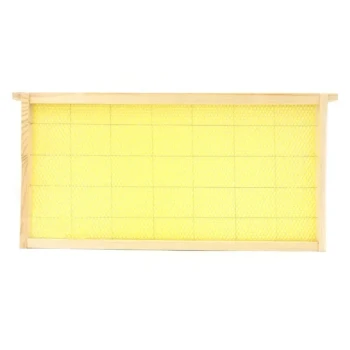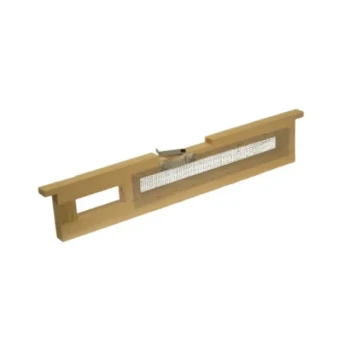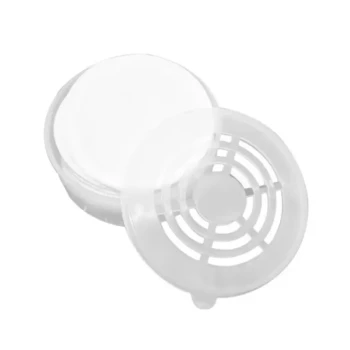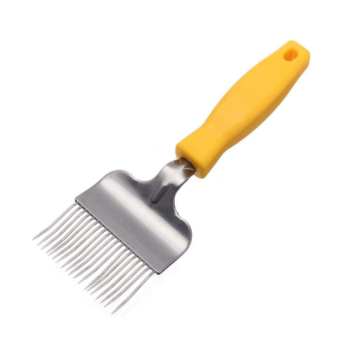Choosing the right bee suit is fundamentally about balancing protection, comfort, and confidence. The best option is made from a durable, light-colored material, fits loosely to prevent stings, and includes critical features like a high-visibility veil, elastic cuffs, and sturdy zippers to seal out any bees.
The most effective bee suit isn't simply a physical barrier; it's a tool that provides the confidence necessary to work calmly and effectively. Your final choice should be guided by your personal comfort level with bees, not just a simple checklist of features.
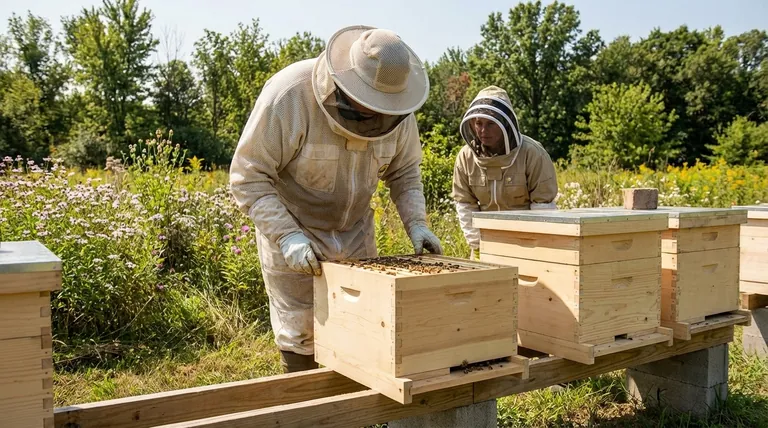
Deconstructing the Bee Suit: Core Components
A high-quality bee suit is a system of integrated parts. Understanding the function of each component allows you to make an informed decision based on your specific needs and environment.
The Importance of Material and Color
Most bee suits are made from a polyester-cotton blend or a multi-layered ventilated fabric. Thicker materials offer more protection, while modern ventilated suits provide superior airflow in warmer climates.
Light colors are standard for a reason. Bees are less likely to perceive light shades as a threat compared to dark colors, which can mimic natural predators.
Achieving the Proper Fit
A bee suit must be slightly baggy. A tight fit pulls the fabric against your skin, making it easier for a bee's stinger to penetrate.
When in doubt, especially between sizes, always choose the larger size. This ensures the fabric hangs away from your body and provides ample room for movement when you bend, crouch, or stretch.
The Veil: Your Window to the Hive
The veil is arguably the most critical component for your confidence. A high-quality veil provides excellent visibility without distortion, allowing you to inspect the hive and read the bees' behavior clearly.
Most modern suits and jackets feature an integrated veil that zips on securely, eliminating gaps.
Critical Entry Points: Zippers, Cuffs, and Ankles
Bees will exploit any gap. A suit must have robust, easy-to-use zippers to ensure a complete seal.
Elasticated cuffs and ankles are non-negotiable. They create a snug fit around your gloves and boots, preventing bees from crawling inside. Some premium suits also include thumb ties to keep sleeves from riding up when you put on your gloves.
Understanding the Trade-offs: Full Suit vs. Jacket
The decision between a full suit and a jacket-and-veil combination is a common one for beekeepers. The right answer depends entirely on your goals and comfort level.
The Case for a Full Suit
A full bee suit offers maximum, head-to-toe protection. This comprehensive coverage provides immense peace of mind, which is particularly valuable for new beekeepers who may feel anxious.
It is the definitive choice when working with a particularly defensive hive or when you want to eliminate any doubt about potential exposure.
The Advantages of a Bee Jacket
A bee jacket is quicker to put on and take off, making it ideal for brief hive inspections. It is also cooler in hot weather and can feel less restrictive than a full suit.
Many experienced beekeepers transition to a jacket once they are comfortable working with their bees and understand their temperament.
The Deciding Factor: Your Psychology
Ultimately, the most important factor is feeling safe. Nervousness or fear can lead to jerky, clumsy movements, which can agitate the bees.
Choose the level of protection that allows you to work with deliberate, calm confidence. For many, that starts with a full suit.
Making the Right Choice for Your Goal
Select your gear based on what will best empower you to be a calm and effective beekeeper.
- If your primary focus is maximum safety as a beginner: A full, light-colored suit is the most reliable choice to build your confidence and let you focus on learning.
- If your primary focus is comfort in a hot climate: Prioritize a suit or jacket made from a multi-layer ventilated material, ensuring all seals at the wrists, waist, and ankles are secure.
- If your primary focus is convenience for quick hive checks: A high-quality bee jacket with an integrated veil offers an excellent balance of essential protection and ease of use.
Your protective gear is the foundation that allows you to focus on the health and well-being of your bees.
Summary Table:
| Factor | Key Consideration | Benefit |
|---|---|---|
| Material & Color | Polyester-cotton blend or ventilated fabric; light colors | Durable protection, better airflow, less likely to agitate bees |
| Fit | Slightly baggy; choose larger size if unsure | Prevents fabric from pressing on skin, reducing sting risk |
| Veil | High-quality, integrated veil with clear visibility | Unobstructed view of hive, secure seal against bees |
| Entry Points | Robust zippers, elastic cuffs/ankles, thumb ties | Seals out bees completely, preventing them from entering suit |
| Type | Full suit (max safety) vs. Jacket (convenience/heat) | Matches your experience level and comfort needs |
Ready to equip yourself with confidence?
At HONESTBEE, we supply commercial apiaries and beekeeping equipment distributors with premium, wholesale-focused bee suits designed for durability, comfort, and maximum protection. Our gear helps you work calmly and effectively, ensuring both your safety and the well-being of your bees.
Contact HONESTBEE today to discuss your bulk supply needs and find the perfect protective solution for your operation.
Visual Guide
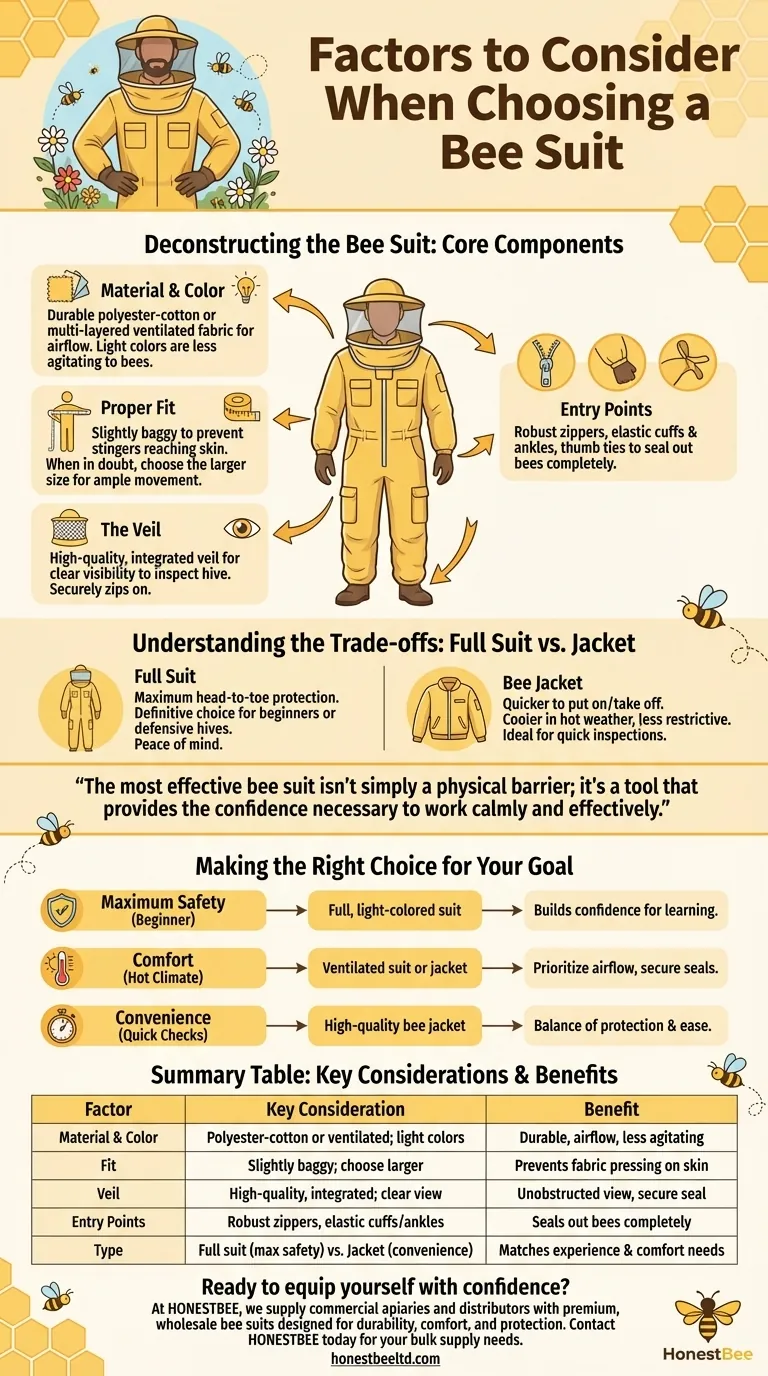
Related Products
- Wholesales Dadant Size Wooden Bee Hives for Beekeeping
- Yellow Plastic Bucket Pail Perch for Beekeeping
- Professional Insulated Winter Hive Wrap for Beekeeping
- Long Langstroth Style Horizontal Top Bar Hive for Wholesale
- Automatic Honey Flow Beehive 4 Frame Mini Hive for Beekeeping
People Also Ask
- What is beekeeping equipment? Essential Tools for Commercial Apiaries & Distributors
- What are the essential pieces of equipment for most beekeepers? Get Started with the Right Gear
- Why were wooden hives traditionally preferred? For Natural Beekeeping Aligned with Bee Biology
- How often should the area under beehives be inspected and cleaned during the warm season? A Proactive Maintenance Guide
- What are the advantages of wooden bee hives? Superior Bee Health & Beekeeper Flexibility









